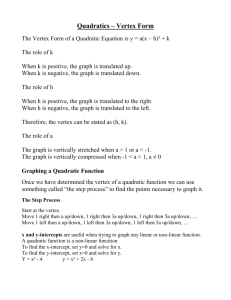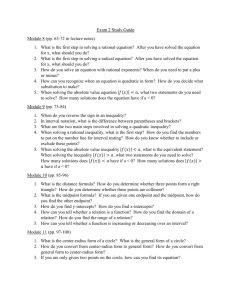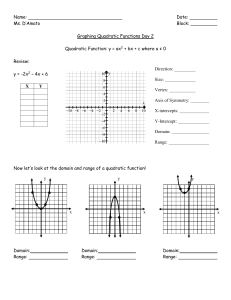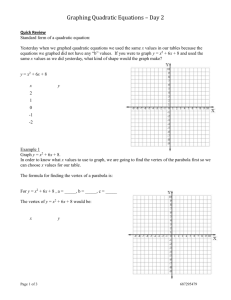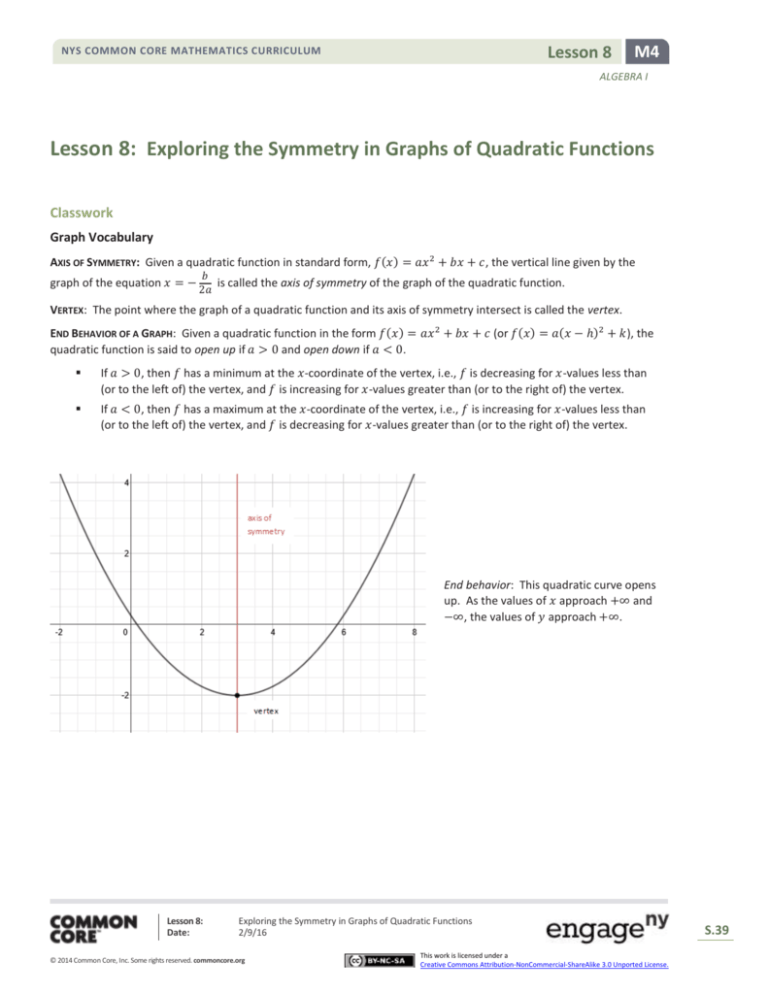
Lesson 8
NYS COMMON CORE MATHEMATICS CURRICULUM
M4
ALGEBRA I
Lesson 8: Exploring the Symmetry in Graphs of Quadratic Functions
Classwork
Graph Vocabulary
AXIS OF SYMMETRY: Given a quadratic function in standard form, 𝑓(𝑥) = 𝑎𝑥 2 + 𝑏𝑥 + 𝑐, the vertical line given by the
graph of the equation 𝑥 = −
𝑏
is called the axis of symmetry of the graph of the quadratic function.
2𝑎
VERTEX: The point where the graph of a quadratic function and its axis of symmetry intersect is called the vertex.
END BEHAVIOR OF A GRAPH: Given a quadratic function in the form 𝑓(𝑥) = 𝑎𝑥 2 + 𝑏𝑥 + 𝑐 (or 𝑓(𝑥) = 𝑎(𝑥 − ℎ)2 + 𝑘), the
quadratic function is said to open up if 𝑎 > 0 and open down if 𝑎 < 0.
If 𝑎 > 0, then 𝑓 has a minimum at the 𝑥-coordinate of the vertex, i.e., 𝑓 is decreasing for 𝑥-values less than
(or to the left of) the vertex, and 𝑓 is increasing for 𝑥-values greater than (or to the right of) the vertex.
If 𝑎 < 0, then 𝑓 has a maximum at the 𝑥-coordinate of the vertex, i.e., 𝑓 is increasing for 𝑥-values less than
(or to the left of) the vertex, and 𝑓 is decreasing for 𝑥-values greater than (or to the right of) the vertex.
End behavior: This quadratic curve opens
up. As the values of 𝑥 approach +∞ and
−∞, the values of 𝑦 approach +∞.
Lesson 8:
Date:
Exploring the Symmetry in Graphs of Quadratic Functions
2/9/16
© 2014 Common Core, Inc. Some rights reserved. commoncore.org
This work is licensed under a
Creative Commons Attribution-NonCommercial-ShareAlike 3.0 Unported License.
S.39
Lesson 8
NYS COMMON CORE MATHEMATICS CURRICULUM
M4
ALGEBRA I
Exploratory Challenge 1
Below are some examples of curves found in architecture around the world. Some of these might be represented by
graphs of quadratic functions. What are the key features these curves have in common with a graph of a quadratic
function?
St. Louis Arch
Bellos Falls Arch Bridge
Arch of Constantine
Roman Aqueduct
The photographs of architectural features above MIGHT be closely represented by graphs of quadratic functions.
Answer the following questions based on the pictures.
a.
How would you describe the overall shape of a graph of a quadratic function?
b.
What is similar or different about the overall shape of the above curves?
IMPORTANT: Many of the photographs in this activity cannot actually be modeled with a quadratic function but rather
are catenary curves. These are “quadratic-like” and can be used for our exploration purposes as they display many of
the same features, including the symmetry we are exploring in this lesson.
Lesson 8:
Date:
Exploring the Symmetry in Graphs of Quadratic Functions
2/9/16
© 2014 Common Core, Inc. Some rights reserved. commoncore.org
This work is licensed under a
Creative Commons Attribution-NonCommercial-ShareAlike 3.0 Unported License.
S.40
Lesson 8
NYS COMMON CORE MATHEMATICS CURRICULUM
M4
ALGEBRA I
Exploratory Challenge 2
Use the graphs of quadratic functions (Graph A and Graph B) to fill in the table and answer the questions on the
following page.
𝒙
𝒇(𝒙)
−1
8
2
−1
4
3
𝒙
𝒇(𝒙)
−3
3
−2
4
1
−5
Graph A
Graph B
Lesson 8:
Date:
Exploring the Symmetry in Graphs of Quadratic Functions
2/9/16
© 2014 Common Core, Inc. Some rights reserved. commoncore.org
This work is licensed under a
Creative Commons Attribution-NonCommercial-ShareAlike 3.0 Unported License.
S.41
Lesson 8
NYS COMMON CORE MATHEMATICS CURRICULUM
M4
ALGEBRA I
Use your graphs and tables of values from the previous page to fill in the blanks or answer the questions for each below.
Graph A
1
𝑥-Intercepts
2
Vertex
3
Sign of the Leading Coefficient
4
Vertex Represents a Minimum
or Maximum?
5
6
7
Points of Symmetry
Increasing and Decreasing
Intervals
Find 𝑓(−1) and 𝑓(5).
Find 𝑓(−1) and 𝑓(−3).
Is 𝑓(7) greater than or less than 8?
Explain
𝑓(2) = −12. Predict the value for
𝑓(−6) and explain your answer.
On what intervals of the domain is
the function depicted by the graph
increasing?
On what intervals of the domain is
the function depicted by the graph
increasing?
On what intervals of the domain is
the function depicted by the graph
decreasing?
On what intervals of the domain is
the function depicted by the graph
decreasing?
What is the average rate of change
for the following intervals?
What is the average rate of change
for the following intervals?
Average Rate of Change on an
[−1, 0]:
Interval
[0, 1]:
[0, 3]:
[1, 3]:
Lesson 8:
Date:
Graph B
[−5, −4]:
[−4, −3]:
[−4, −1]:
[−3, −1]:
Exploring the Symmetry in Graphs of Quadratic Functions
2/9/16
© 2014 Common Core, Inc. Some rights reserved. commoncore.org
This work is licensed under a
Creative Commons Attribution-NonCommercial-ShareAlike 3.0 Unported License.
S.42
Lesson 8
NYS COMMON CORE MATHEMATICS CURRICULUM
M4
ALGEBRA I
Understanding the symmetry of quadratic functions and their graphs (Look at row 5 in the chart and the tables.)
a.
What patterns do you see in the tables of values you made next to Graph A and Graph B?
Finding the vertex and axis of symmetry (Look at rows 1 and 2 of the chart.)
b.
How can we know the 𝑥-coordinate of the vertex by looking at the 𝑥-coordinates of the zeros (or any pair of
symmetric points)?
Understanding end behavior (Look at rows 3 and 4 of the chart.)
c.
What happens to the 𝑦-values of the functions as the 𝑥-values increase to very large numbers? What about as
the 𝑥-values decrease to very small numbers (in the negative direction)?
d.
How can we know whether a graph of a quadratic function will open up or down?
Lesson 8:
Date:
Exploring the Symmetry in Graphs of Quadratic Functions
2/9/16
© 2014 Common Core, Inc. Some rights reserved. commoncore.org
This work is licensed under a
Creative Commons Attribution-NonCommercial-ShareAlike 3.0 Unported License.
S.43
Lesson 8
NYS COMMON CORE MATHEMATICS CURRICULUM
M4
ALGEBRA I
Identifying intervals on which the function is increasing or decreasing (Look at row 6 in the chart.)
e.
Is it possible to determine the exact intervals that a quadratic function is increasing or decreasing just by
looking at a graph of the function?
Computing average rate of change on an interval (Look at row 7 in the chart.)
f.
Explain why the average rate of change over the interval [1, 3] for Graph A was zero.
g.
How are finding the slope of a line and finding the average rate of change on an interval of a quadratic function
similar? How are they different?
Finding a unique quadratic function
h.
Can you graph a quadratic function if you don’t know the vertex? Can you graph a quadratic function if you
only know the 𝑥-intercepts?
Lesson 8:
Date:
Exploring the Symmetry in Graphs of Quadratic Functions
2/9/16
© 2014 Common Core, Inc. Some rights reserved. commoncore.org
This work is licensed under a
Creative Commons Attribution-NonCommercial-ShareAlike 3.0 Unported License.
S.44
Lesson 8
NYS COMMON CORE MATHEMATICS CURRICULUM
M4
ALGEBRA I
i.
Remember that we need to know at least two points to define a unique line. Can you identify a unique
quadratic function with just two points? Explain.
j.
What is the minimum number of points you would need to identify a unique quadratic function? Explain why.
Exploratory Challenge 3
Below you see only one side of the graph of a quadratic function. Complete the graph by plotting three additional points
of the quadratic function. Explain how you found these points, and then fill in the table on the right.
𝒙
Lesson 8:
Date:
𝒇(𝒙)
Exploring the Symmetry in Graphs of Quadratic Functions
2/9/16
© 2014 Common Core, Inc. Some rights reserved. commoncore.org
This work is licensed under a
Creative Commons Attribution-NonCommercial-ShareAlike 3.0 Unported License.
S.45
Lesson 8
NYS COMMON CORE MATHEMATICS CURRICULUM
M4
ALGEBRA I
a.
What are the coordinates of the 𝑥-intercepts?
b.
What are the coordinates of the 𝑦-intercept?
c.
What are the coordinates of the vertex? Is it a minimum or a maximum?
d.
If we knew the equation for this curve, what would the sign of the leading coefficient be?
e.
Verify that the average rate of change for the interval −3 ≤ 𝑥 ≤ −2, or [−3, −2], is 5. Show your steps.
f.
Based on your answer to row 6 in the table for Exploratory Challenge 2, what interval would have an average
rate of change of −5? Explain.
Lesson 8:
Date:
Exploring the Symmetry in Graphs of Quadratic Functions
2/9/16
© 2014 Common Core, Inc. Some rights reserved. commoncore.org
This work is licensed under a
Creative Commons Attribution-NonCommercial-ShareAlike 3.0 Unported License.
S.46
Lesson 8
NYS COMMON CORE MATHEMATICS CURRICULUM
M4
ALGEBRA I
Lesson Summary
Quadratic functions create a symmetrical curve with its highest (maximum) or lowest (minimum) point
corresponding to its vertex and an axis of symmetry passing through the vertex when graphed. The 𝑥-coordinate of
the vertex is the average of the 𝑥-coordinates of the zeros or any two symmetric points on the graph.
When the leading coefficient is a negative number, the graph opens down, and its end behavior is that both ends
move towards negative infinity. If the leading coefficient is positive, the graph opens up, and both ends move
towards positive infinity.
Problem Set
1.
Khaya stated that every 𝑦-value of the graph of a quadratic function has two different 𝑥-values. Do you agree or
disagree with Khaya? Explain your answer.
2.
Is it possible for the graphs of two different quadratic functions to each have 𝑥 = −3 as its line of symmetry and
both have a maximum at 𝑦 = 5? Explain and support your answer with a sketch of the graphs.
Lesson 8:
Date:
Exploring the Symmetry in Graphs of Quadratic Functions
2/9/16
© 2014 Common Core, Inc. Some rights reserved. commoncore.org
This work is licensed under a
Creative Commons Attribution-NonCommercial-ShareAlike 3.0 Unported License.
S.47
Lesson 8
NYS COMMON CORE MATHEMATICS CURRICULUM
M4
ALGEBRA I
3.
Consider the following key features discussed in this lesson for the four graphs of quadratic functions below:
𝑥-intercepts, 𝑦-intercept, line of symmetry, vertex, and end behavior.
Graph A
Graph B
Graph C
4.
Graph D
a.
Which key features of a quadratic function do graphs A and B have in common? Which features are not
shared?
b.
Compare graphs A and C and explain the differences and similarities between their key features.
c.
Compare graphs A and D and explain the differences and similarities between their key features.
d.
What do all four of the graphs have in common?
Use the symmetric properties of quadratic functions to sketch the graph of
the function below, given these points and given that the vertex of the
graph is the point (0, 5).
(0, 5)
(1, 3)
(2, − 3)
Lesson 8:
Date:
Exploring the Symmetry in Graphs of Quadratic Functions
2/9/16
© 2014 Common Core, Inc. Some rights reserved. commoncore.org
This work is licensed under a
Creative Commons Attribution-NonCommercial-ShareAlike 3.0 Unported License.
S.48





